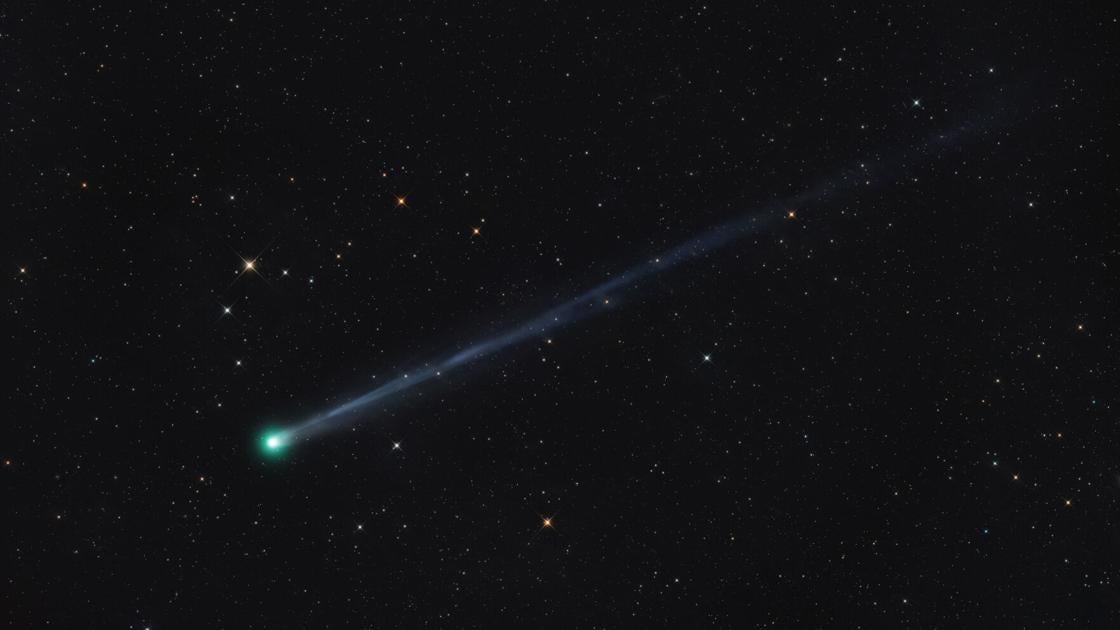A newly discovered comet could be visible to the naked eye this week, and its name should give you a clue about where it was spotted first.
Comet C/2025 A6 (Lemmon) was discovered early this year by one of the telescopes on — you guessed it — Mount Lemmon, where the University of Arizona operates a wildly prolific monitoring network dedicated to finding so-called near-Earth objects that could pose a threat to our planet.
The Catalina Sky Survey leads the world when it comes to cataloging new comets and asteroids. Close to half of all known near-Earth objects were discovered in the past 27 years by staff members at the NASA-funded, mountain-top survey run by the U of A’s Lunar and Planetary Laboratory.
People are also reading…
Catalina Sky Survey director Carson Fuls was the first to notice Comet Lemmon, though he couldn’t tell what it was at the time.
He said it was “just a point” in an image captured on Jan. 3 by the 60-inch Mount Lemmon Survey telescope, so he reported it as a possible asteroid to the Minor Planet Center, a global database maintained by the International Astronomical Union for tracking such things.
The Minor Planet Center ultimately identified it as a comet on Feb. 21, based on follow-up observations.
Comet Lemmon poses no risk to our planet. The closest it will get to us is roughly 55 million miles away, and that already happened at around 5 p.m. local time on Monday.
Fuls said current projections suggest Lemmon may grow slightly brighter in the sky through Oct. 27, when it should begin to dim.
Fuls
University of Arizona
“Comets are kind of notoriously hard to predict when it comes to how bright they’re going to get,” he said.
If you know just where to look, Comet Lemmon is already what astronomy buffs call “backyard visible” with a pair of binoculars or a small telescope.
Fuls said he found it from his house in the Catalina Foothills on Sunday night using a pair of bird-watching binoculars, though it wasn’t easy, even for him. “I could see the corona and a bit of the tail,” he said. “It was still quite dim.”
The best way to see it is to go outside at about 6:30 or 7 p.m., roughly 30 minutes to an hour after sunset, and look north toward the Big Dipper. Lemmon will be located just below and to the west of the Dipper’s handle, Fuls said.
It is supposed to be the brightest comet of 2025, he said, but it is unlikely to be visible with the naked eye except in very dark places, free of most light pollution.
Comet C/2025 A6 (Lemmon), or Comet Lemmon for short, glows green in a photo captured in late September by Adam Block from the University of Arizona’s Steward Observatory.
Adam Block/Steward Observatory/University of Arizona
This is Comet Lemmon’s first visit to the inner solar system in about 1,350 years. It won’t be back again for another 1,150 years or so.
In photos captured so far by astrophotographers, Lemmon glows green as a result of photons from the sun exciting carbon in the coma surrounding the flying ball of rocks, dust and melting ice, Fuls said. “The color helps us figure out — to some extent — what the comet is made of.”
The Catalina Sky Survey operates nightly, except during the full moon, using nine full-time observers in staggered shifts. Each observer typically works three nights in a row and sleeps during the day between shifts in the crew quarters on the mountain. “It’s kind of a tough schedule,” Fuls said, but the people doing it tend to love the work.
Instead of peering through the eyepiece of a telescope, they spend most of their time in front of a monitor, searching for unidentified asteroids and other objects in fresh images of the sky collected by as many as five different scopes used by the survey.
Advances in optics, computers and tracking software have made the job significantly easier over the years, but no replacement has yet been found for human eyes and intuition, Fuls said. “There is always a person in that loop.”
A comet that could be visible to the naked eye this week was discovered in January using this 60-inch telescope on Mount Lemmon, part of the University of Arizona’s Catalina Sky Survey.
University of Arizona Catalina Sky Survey
Had Lemmon been recognizable in that first image from Jan. 3, when it was still more than 418 million miles from the sun, we’d all be referring to it as Comet Fuls now.
New comets are automatically named after the individuals who discover them, but only if the objects are identified as comets right away. Otherwise, they take the name of the facility that captured the first images of them, once they have been confirmed as comets.
That’s why this Comet Lemmon is by no means the only Comet Lemmon. No fewer than 66 of them have been discovered from — and named for — the survey telescope on Mount Lemmon since 2006. Lemmon also appears in the hyphenated names of at least 19 other comets, for which the telescope north of Tucson is listed as the co-discoverer.
But don’t feel bad for Fuls. He already has his name on 10 comets he has discovered himself since 2017 — a total that puts him in the middle of the pack among current observers with the Catalina Sky Survey.
According to the survey’s website, deputy director Alex Gibbs is the active leader with 33 comet discoveries. Rob McNaught, a former observer for the survey in Australia, holds the all-time record with 82.
Though its primary mission is to locate potentially dangerous asteroids in our immediate cosmic neighborhood, the Catalina Sky Survey has now discovered more than 570 comets, including that faint green smudge currently painting the evening sky to the north of Tucson.
